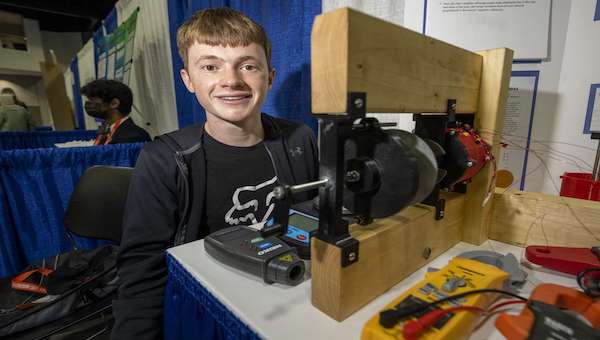 Robert Sansone - Society for Science
Robert Sansone - Society for Science
17-YEAR-OLD DESIGNS GREENER MOTOR THAT COULD REVOLUTIONIZE EVS
BY: SAMI GROVERSITE: TREEHUGGER
TRENDING
Activism
AI
Belief
Big Pharma
Conspiracy
Cult
Culture
Economy
Education
Entertainment
Environment
Faith
Global
Government
Health
Hi Tech
Leadership
Politics
Prophecy
Science
Security
Social Climate
Universe
War
"Even though electric vehicles might help us in transition away from fossil fuels, they also create these new problems in terms of polluting and often unstable supply chains.”
When I started my video call with Robert Sansone, I had to offer a disclaimer: While I write regularly about the experience of driving electric vehicles, and about policies that promote them, my expertise stops when you pop the hood and look at what actually drives them.
That disclaimer was well worth giving. You see, Sansone, a 17-year-old high school student, just won first prize at the Regeneron International Science and Engineering Fair (ISEF) for a magnet-free synchronous reluctance motor that could, according to event organizers and Smithsonian Magazine , one day revolutionize the electric vehicle industry. The prize , which includes $75,000, has brought significant attention to the young engineer, who was kind enough to explain to me—in lay person’s terms—what had led him to these experiments.
“I’ve always been a maker and designer. A little over a year ago, I started looking into the pros and cons of electric vehicles," says Sansone. "One disadvantage that continually came up was the rare earth materials that are used in their permanent magnet motors. These materials are very bad for the environment, partially because they are usually found alongside radioactive materials like uranium and thorium."
"Mining and extracting them involves extremely harsh solvents, creates radioactive waste, and costs thousands of dollars a kilogram. So even though electric vehicles might help us in transition away from fossil fuels, they also create these new problems in terms of polluting and often unstable supply chains.”
As Sansone dug deeper into his research, he came across claims that synchronous reluctance motors—which use no permanent magnets—could potentially offer a solution to this thorny problem. The only trouble was these motors are currently no match for their more powerful permanent magnet counterparts, both in terms of efficiency and torque.
“My design is potentially patentable, so I can’t share all of the specifics. But what I can tell you is that in a synchronous reluctance motor, you have a rotor made of magnetic materials—iron or steel—with slots cut into it," says Sansone. "This rotor sits inside a stator, which is made up of coils of wire. The steel of the rotor represents low reluctance—because magnetic fields can pass through it easier than air—while the slots represent high reluctance. You want to have the maximum difference between high and low reluctance, as a greater difference in reluctance increases the motor’s saliency ratio, which is a determining factor for the torque it can produce. My design uses a novel configuration to improve this saliency ratio.”
:max_bytes(150000):strip_icc()/experimental_setup_2-561df06924a649e5be9ca04927f90ede.jpg)
Society for Science
According to Sansone’s experiments, his initial design modifications showed 39% greater torque, and 31% greater efficiency, when tested at 300 revolutions per minute (rpm)—and 37% in efficiency and 40% increase in torque at 750 rpm.
As for exactly how that stacks up with the current generation of permanent magnet motors, Sansone says it is a little too early to say. “Permanent magnet motors are some of the most powerful electric motors ever made," he says. "The motor in a Tesla can reach 18,000 rpm. With the resources available to me, I was building with 3D-printed components that just can’t be tested under those types of conditions without melting. I am, however, working on the next version to compare it more directly to a permanent magnet design.”
Sansone explains he is also working on incorporating two other design changes, in addition to the novel configurations used in this award-winning experiment. “I’ve been working on this for quite some time. I have three potential design changes which should each improve the performance of a conventional synchronous reluctance motor. The version that won the ISEF award was Version 15, which just incorporates one of these changes. Version 16, which I am currently working on, will incorporate a second. And then Version 17 will incorporate all three. It’s at this point that the design becomes potentially patentable, and we’ll be better able to tell how it competes with permanent magnet motors.”
Given the dizzying speeds with which electric vehicle technology is progressing, Sansone is clearly entering a highly competitive field. Yet the exposure he has gained through the ISEF prize is already bolstering his work in real and meaningful ways. “Winning the ISEF is a dream come true for me. I’ve had lots of folks reach out to me with offers of internships, help with research, connections—all of which will be a huge help to me in the future," he says.
Despite my aforementioned technological limitations, I left my conversation with Sansone fully believing that he will shake up the world of science and engineering in pursuit of a clean tech future. As we closed out our discussion, I asked him if there was anything we hadn’t discussed that he would like to include in the interview. He did not hesitate.
“I didn’t have a huge amount of help. I didn’t have a mentor. When things failed, I had to do research and trial and error, and then figure out a path forward. My project proves that younger people like myself—who are aspiring to work in STEM—don’t have to wait for college, or a job, in order to make a difference. I found ways to get around limited resources. I needed a dynamometer, for example, which usually cost thousands of dollars. But I figured out a way to make my own. Even with limited resources, it doesn’t prevent me from doing the projects I want to do. And I hope others can do the same.”
Click 3 Dots Below to View Complete Sidebar



